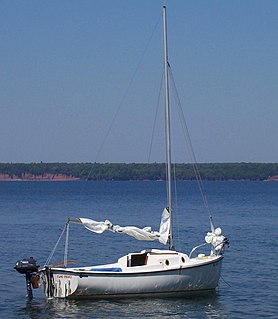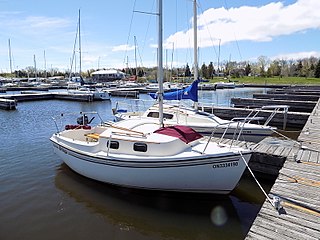Related Research Articles
The Newport 16 is an American trailerable sailboat that was designed by Bill Lapworth as a daysailer and a pocket cruiser and first built in 1965.

The Catalina 22 is an American trailerable sailboat that was designed by Frank V. Butler and first built in 1969.

The Com-Pac 16 is an American trailerable sailboat that was designed by Clark Mills as a small cruiser and first built in 1972.
The Redline 41 is a series of sailboat designs, first built in 1967 and that remained in production in 2017. The first two designs were by Cuthbertson & Cassian and the more recent one by Mark Mills.

The Sanibel 18 is an American trailerable sailboat, that was designed by Charles Ludwig, first built in 1982 and named for the Floridian town and island.

The C&C 25 is a series of Canadian sailboats, first built in 1973.

The Com-Pac 19 is an American trailerable sailboat, that was designed by Robert K. Johnson and first built in 1979.

The Catalina 28 is an American sailboat, that was designed by Gerry Douglas and first built in 1991.
The C&C 40 is a series of Canadian sailboats, that were all designed by C&C Design and first built in 1968.
The Silhouette also called the Silhouette 17, is a British trailerable sailboat that was designed by Robert Tucker as a pocket cruiser and first built in 1954.
The Newport 41 is a family of American sailboats that was designed by C&C Design as International Offshore Rule (IOR) racer-cruisers and first built in about 1972.
The Typhoon 18 is a family of American trailerable sailboats that was designed by Carl Alberg as day sailers and cruisers, first built in 1967.
The Aquarius 23 is an American trailerable sailboat that was designed by Peter Barrett and Stan Miller as a cruiser and first built in 1969.
The Buccaneer 240 and Buccaneer 245 are a family of American trailerable sailboats that were both designed as cruisers and first built in 1975.
The Com-Pac Eclipse is an American trailerable sailboat that was designed by the Hutchins Design Team as a pocket cruiser and first built in 2004.
The Cornish Crabber 24 is a series of British trailerable sailboats, designed by Roger Dongray as cruisers and first built in 1974.
The Ericson 25+, also called the Ericson 25 Mark II, is an American trailerable sailboat that was designed by Bruce King as a cruiser and first built in 1978.
The ETAP 21i is a Belgian trailerable sailboat that was designed by Mortain & Mavrikios as a cruiser and first built in 1997.
The Santana 23 is an American trailerable sailboat that was designed by W. Shad Turner as a racer-cruiser and first built in 1978. It was produced in two versions with different keels and rigs.
The Windrose 22 and Laguna 22 are a series of American trailerable sailboats that were designed by W. Shad Turner as cruisers and first built in 1977.
References
- 1 2 3 4 5 6 7 McArthur, Bruce (2020). "Com-Pac 23 sailboat". sailboatdata.com. Archived from the original on 22 February 2021. Retrieved 22 February 2021.
- 1 2 McArthur, Bruce (2020). "Com-Pac 23 Mk 2 sailboat". sailboatdata.com. Archived from the original on 22 February 2021. Retrieved 22 February 2021.
- 1 2 McArthur, Bruce (2020). "Com-Pac 23 sailboat". sailboatdata.com. Archived from the original on 22 February 2021. Retrieved 22 February 2021.
- 1 2 McArthur, Bruce (2020). "Com-Pac 23 Pilothouse sailboat". sailboatdata.com. Archived from the original on 22 February 2021. Retrieved 22 February 2021.
- ↑ McArthur, Bruce (2020). "Clark Mills 1915 - 2001". sailboatdata.com. Archived from the original on 20 August 2020. Retrieved 22 February 2021.
- 1 2 3 4 5 6 7 8 9 10 Henkel, Steve: The Sailor's Book of Small Cruising Sailboats, page 225. International Marine/McGraw-Hill, 2010. ISBN 978-0-07-163652-0
- 1 2 3 Com-Pac Yachts (2021). "The Com-Pac 23/IV". www.com-pacyachts.com. Archived from the original on 22 February 2021. Retrieved 22 February 2021.
- 1 2 3 Com-Pac Yachts (2021). "The CP 23 Pilothouse". www.com-pacyachts.com. Archived from the original on 22 February 2021. Retrieved 22 February 2021.
- ↑ McArthur, Bruce (2021). "Com-Pac Yachts/ Hutchins Co". sailboatdata.com. Archived from the original on 25 September 2020. Retrieved 22 February 2021.
- ↑ Kretschmer, John (10 November 2008). "Com-Pac 23". Sailing Magazine. Archived from the original on 23 February 2021. Retrieved 22 February 2021.
- ↑ Prochazka, Zuzana (5 January 2012). "Com-Pac 23 Pilothouse: Pocket Sailboat". boats.com. Archived from the original on 23 February 2021. Retrieved 22 February 2021.